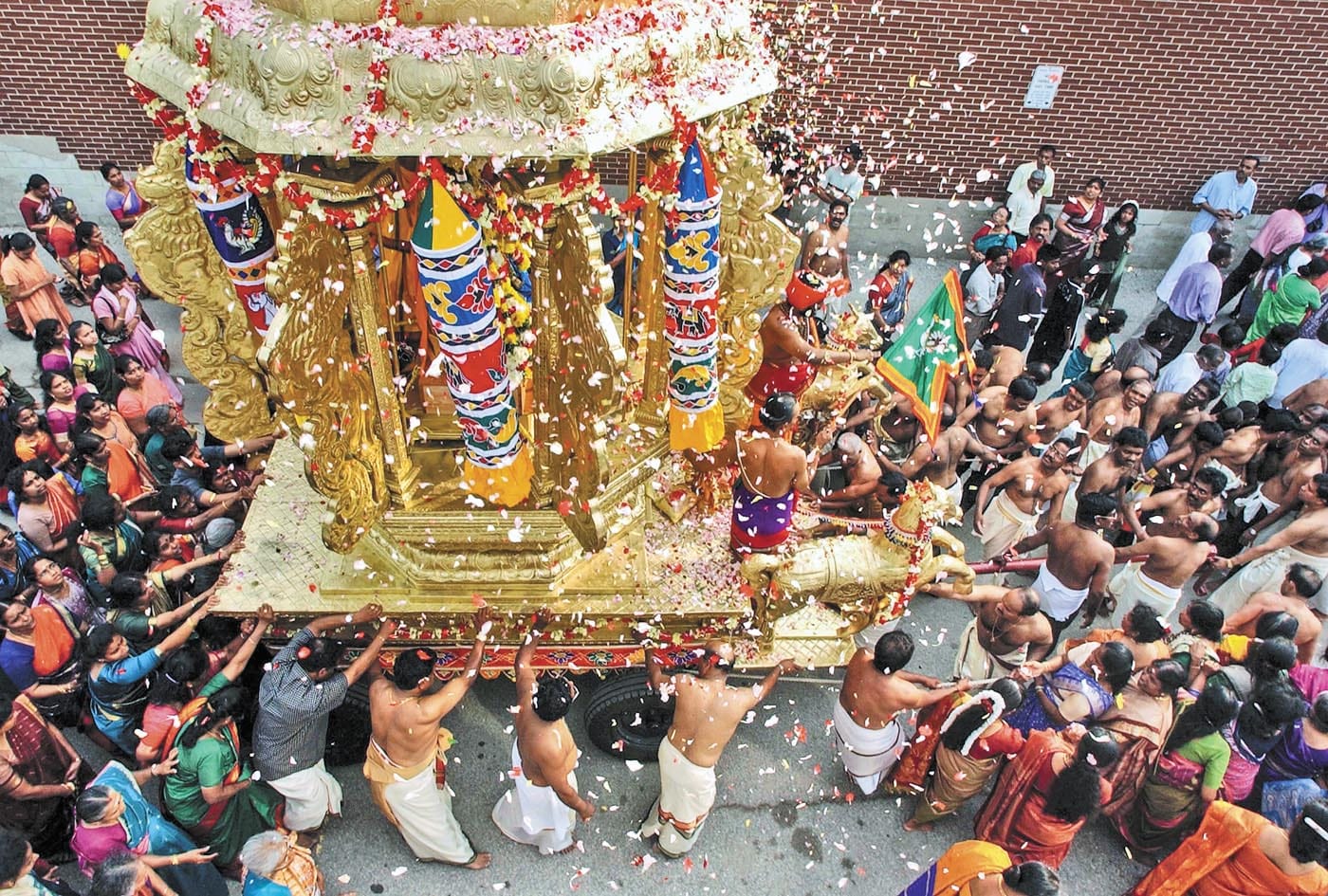Hinduism is celebratory by nature. Hindus miss no opportunity to set mundane matters aside and join with family, friends, neighbors and strangers alike to feast and have fun, to renew the home and the heart and, most importantly, draw nearer to God.
Festivals are perhaps more impressive and varied in Hinduism than in any other religion. The devout Hindu knows these are times of profound mysticism, when God and the Gods touch our world, revitalize our souls, lighten karmas and bless our families.
Yet festivals do even more than this: they are essential to the perpetuation of religion, periodically reigniting the spark of zeal and devotion in the community. They provide the spiritual public square where Hindus engage with one another, affirming shared values and enjoying life’s intersections.
Before each celebration, vows are taken, scriptures are studied, pilgrimages are trodden and fasts observed in preparation–all individual acts of intimate devotion that bring the devotee closer to the Gods and keep him on the path to his inmost Self. As each festival begins, solitary adoration becomes a collective ritual, with millions of people taking their places in an ad-hoc choreography. Tradition is followed but the result is never the same; every festival is special and unforgettable in its own way.
Thus the Hindu is reminded of his faith by the sounds, scents and the wild medley of tastes laid out for the feast. His mind and emotions are imbued with Hinduism as sacred mantra prayers are intoned, the spiritual teachings are recounted by saints and the Gods are praised in melodious bhajans.
Each state of India, indeed each village, lends a little of its unique culture to how a festival is celebrated, creating almost endless variations. But recently, with the growing Hindu population outside of India, festivals have acquired an international dimension. They provide a window into Hinduism for the non-Hindu populations in countries as far flung as Norway, Chile and Canada. At the same time, for Hindus immersed in foreign and often very alien cultures, festivals are the most visible and memorable sign of their heritage. Celebrated with unmatched fervor but with paced regularity, festivals serve as a reminder of one’s identity and allegiance to Hindu traditions and ideals.
What could be more entertaining, alive, vibrant and yet pious and rich in symbolism than a Hindu festival? Professor Dr. Shiva Bajpai remarked that it is through festivals that most Hindus experience their religion: “Festivals, pilgrimages and temple worship are the faith armor of Hindus.”
HINDU FESTIVALS FOR THE MEDIA
Hinduism Today is reaching out with accurate and uplifting information about Hinduism
Imprecise information, unflattering photos and an obsession for the bizarre are common when the media features our faith. For most Hindus, there seems little or nothing that can be done about this, except to practice detachment and soulful acceptance. That was the tone at a 2007 Hindu conference in Dallas, Texas, when suddenly the leaders collectively declared “Enough.” Determined to complain less and do more, they masterminded the Hindu Festival Media Initiative, a strategic project designed by Hinduism Today in collaboration with the Sanatana Dharma Foundation.
There could be no better time to educate the American people about Hindu religion and culture. In 2009, for example, President Obama attended the first Diwali celebration at the White House, a historic moment, complete with Sanskrit chants. Yet, a proper description of the Hindu festival could be found only in the President’s inspired speech, for not a single media report rightly explained the festival of lights. Festivals are the obvious topic of choice to introduce Hinduism to the American masses.
The Pager Project: We selected fifteen major festivals as the core of the project and, in collaboration with Soumya Sitaraman of Bangalore, created a series of “pagers,” ready-to-print, newspaper-sized posters. They match standard US newspapers in journalistic style and size, making them easy to use, especially for small publishers with limited staff. Each pager highlights a festival in its celebratory, community and family aspects. In the “Fact and Fiction” section and elsewhere, the pagers take the opportunity to introduce Hindu philosophical, cultural and spiritual ideas.
How the Program Works: Newspapers (especially in these days of budgetary cutbacks) welcome input from faith communities if the material is of high editorial quality, with polished text and eye-catching photos, more so if it’s free. Motivated Hindus are encouraged to approach their local newspapers’ religion or lifestyle editors with the appropriate pager in the weeks before each festival. Editors may elect to use them as is, or draw from the graphics and words and adapt them to their own style. Television and public radio stations can also be approached; the pagers can provide a comprehensive and authentic summary for voice-overs. They are available on the web as teaching resources for families, schools, summer camps, temples, ashrams, bloggers, etc.
How You Can Participate: Talk to your local temple board, the local Hindu association and newspapers in your area. Visit [https://www.hinduismtoday.com/category/major-hindu-festivals/] for more information. There you will find all the pagers in PDF with instructions on how to best use them. No matter where you live, these festival summaries will provide your local media with informative, factual information about your faith. By preemptively explaining how Hindus experience and understand Sanatana Dharma, we bridge the we-they cultural gap and participate proactively in bringing more tolerance, acceptance and understanding into the world.
Go to the festival table of contents [https://www.hinduismtoday.com/modules/smartsection/category.php?categoryid=391]


